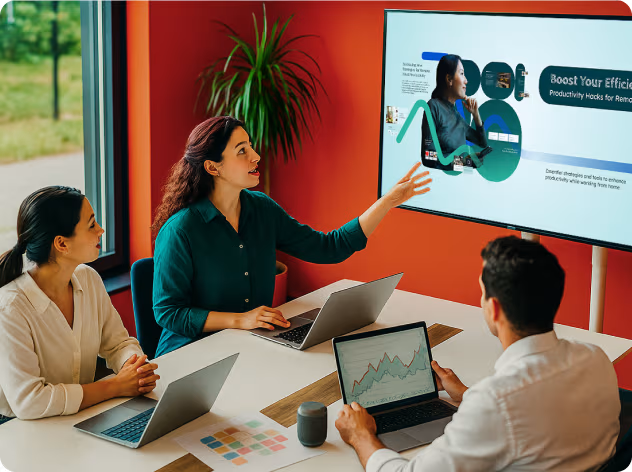Work faster with Prezi AI
Transform your work from idea to presentation in seconds.
Build a smart, engaging training session for remote teams with tools, trends, and actionable tips.
Pitch my Mexican food truck concept with fresh food and fresher ideas. Include a clear growth plan and captivating visuals.
Showcase a creative marketing strategy for a tech brand that highlights recent KPIs, market trends, and what’s next.
Create a data-driven sales pitch for my finance company that highlights key wins, trends, and opportunities for new customers.
Analyze performance metrics and strategies for a sound development business review. Forecast what’s next with bold visuals, charts, and clear takeaways.
Upload your deck. Get a better one back.
Upload your outline or current presentation and we’ll transform it into a ready-to-present cinematic experience.

Trusted by organizations that know the power of great presentations
Why top performers choose Prezi
Save hours building decks
Transform your ideas, outlines, and decks into polished presentations in seconds. Stay ahead of deadlines and get results quickly.
PPTX, PDF, and DOCX import
Import your existing files and get started fast. It’s never been easier to transform your work.
Custom presentations in seconds
Describe your idea and Prezi AI designs your outline and presentation in seconds. You’re in full control.
Win the room with every slide
Look like a design pro with no design skills needed. Prezi gives you everything you want to create stunning presentations for your work.
Show up on brand
Upload your logo and Prezi AI will automatically create on-brand color palettes that you can apply instantly.
Have a designer by your side
One-click design suggestions make it so every choice is the right one. Then, make your message shine with AI text improvements.
Stand out from the crowd
Showcase you and your content from anywhere, anytime, with Prezi Video. Ideal for virtual, hybrid, or recorded presentations.
You and your content, together on screen
Present live alongside your content over your favorite video conferencing tool. Keep the human connection alive.
Record presentations
Download video files to easily save and share anywhere.
See why our customers love us
Prezi ranks as the attention-grabbing presentation leader across industries based on hundreds of glowing customer reviews.
What our audience is saying
“Prezi offers an amazing alternative to traditional slide-based presentations.”
Since my company adopted Prezi over standard PowerPoint, the response to completing a training or sales demo has been overwhelmingly well-received.
“Prezi AI saved a lot of time and really looked professional.”
“The presentations are unique, professional, and memorable. People always ask what platform I am using.”
“Prezi makes people pay attention compared to traditional slide decks.”
“This is a tool that is going to put you ahead of other people and make you look professional and make your ideas stand out.”

More control for the whole team
Give your entire team the business presentation tool they need to create standout content—whether they’re in marketing, consulting, sales, training, or HR. With Prezi for business, every team member can create and deliver presentations that win attention, reflect your brand, and drive results.
Join 160M+ and present better





















